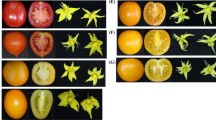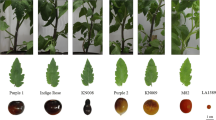Abstract
Genes along the anthocyanin biosynthetic pathway have been some of the most useful genetic markers for both molecular and classical genetic studies. In order to exploit such markers for molecular studies in tomato, we have cloned and characterized genes encoding two steps in the pathway, chalcone synthase (CHS) and dihydroflavonol 4-reductase (DFR). We show that CHS is comprised of a multigene family with at least two unlinked genes being actively expressed in hypocotyls. These genetic results offer an explanation for the biochemical finding that none of the characterized anthocyanin-deficient tomato mutants completely lacks CHS activity. In contrast, a number of lines of evidence support the conclusion that DFR is encoded by a single gene in tomato: 1) only one class of cDNA transcript has been recovered from multiple isolations, 2) this transcript maps to a single genetic locus, 3) the intensity and banding pattern on Southern blots using this cDNA as a probe is consistent with there being only one DFR sequence at this locus, and 4) a single mutation, anthocyanin without (aw), completely abolishes DFR activity. A genomic clone of DFR was introduced into a line homozygous for the aw mutation by Agrobacterium transformation. While the aw mutation results in the absence of anthocyanin pigmentation, transformants containing a DFR transgene were fully pigmented. Hybridization analysis of progeny segregating for the presence or absence of anthocyanin indicated that pigmenation resulted from complementation by the DFR transgene. In addition to showing that the aw locus encodes the structural gene for DFR, these experiments demonstrate the applicability of DFR as a non-destructive, easily scored, visual marker for tomato.
Similar content being viewed by others
References
Beld, M., C. Martin, H. Huits, A.R. Stuitje & A.G.M. Gerats, 1989. Flavonoid synthesis in Petunia hybrida: partial characterization of dihydroflavonol 4-reductase genes. Plant Mol. Biol. 13: 491–502.
Bevan, M., W.M. Barnes & M.D. Chilton, 1983. Structure and transcription of the nopaline synthase gene region of T-DNA. Nucl. Acids Res. 11: 369–385.
Bongue-Bartelsman, M., S.D. O'Neill, Y. Tong & J.I. Yoder, 1993. Characterization of the dihydrofalavonol-reductase gene in tomato. Gene 138: 153–157.
Dooner, H.K., T.P. Robbins & R.A. Jorgensen, 1991. Genetic and developmental control of anthocyanin biosynthesis. Annu. Rev. Genet. 25: 173–199.
Fedoroff, N.V., 1989. Maize transposable elements. In: Berg, D.E. & M.M. Howe (Eds.), Mobile DNA, pp. 375–411. American Society for Microbiology, Wahsington D.C.
Goldsbrough, A., F. Belzile & J.I. Yoder, 1994. Complementation of the tomato anthocyanin without (aw) mutant using the dihydroflavonol 4-reductase gene. Plant Physiol. 105: 491–496.
Heller, W. & G. Forkmann, 1988. In: J.B. Harborne (Ed.), The Flavonoids. pp. 399–425. Chapman and Hall, Ltd., London.
Jefferson, R.A., T.A. Kavanagh & M.W. Bevan, 1987. GUS fusions: β-glucuronidase as a sensitive and versatile gene fusion marker in higher plants. EMBO J. 6: 3901–3907.
Jones, J.D.G., D.A. Jones, G. Bishop, K. Harrison, B. Carroll & S. Scofield, 1993. Use of the maize transposons Activator and Dissociation to show that chimeric genes for resistance to phosphinotricin and spectinomycin act non-cell autonomously in tobacco and tomato seedlings. Transgen. Res. 2: 63–78.
McClintock, B., 1956. Controlling elements and the gene. CSHSQB 21, 197–216.
Mutschler, M.A., C.M. Rick & S.D. Tanksley, 1987. Linkage maps of the tomato (Lycopersicon esculentum). Tomato Genet. Coop. Rep. 37: 5–33.
O'Neill, S.D., Y. Tong, B. Spörlein, G. Forkmann & J.I. Yoder, 1990. Molecular genetic analysis of chalcone synthase in Lycopersicon esculentum and an anthocyanin deficient mutant. Mol. Gen. Genet. 224: 279–288.
O'Reilly, C, N. Shepherd, A. Pereira, Z. Schwarz-Sommer, I. Bertram, D.S. Robertson, P.A. Peterson & H. Saedler, 1985. Molecular Cloning of the A1 locus of Zea mays using the transposable elements En and Mu1. EMBO J. 4: 877–882.
Osborne, B.I., C.A. Corr, J.P. Prince, R. Hehl, S.D. Tanksley, S. McCormick, & B. Baker, 1991. Ac transposition from a T-DNA can generate linked and unlinked clusters of insertions in the tomato genome. Genetics 129: 833–844.
Ow, D.W., V. Wood, M. DeLuca, J.R.de Wet, D.R. Helinski & S.H. Howell, 1986. Transient and stable expression of the firefly luciferase gene in plant cells and transgenic plants. Science 234: 865–859.
Rick, C.M., 1993. Additional allele tests of anthocyanin deficiencies. Tomato Genet. Coop. Rep. 43: 40.
Rick, C.M. & R.T. Chetelat, 1993. Stock List. Tomato Genet. Coop. Rep. 43: 53–78.
Rommens, C.M.T., G.N. Rudenko, P.P. Dijkwel, M.J.J.van Haaren, P.B.F. Ouwerkerk, K.M. Blok, H.J.J. Nijkamp & J. Hille, 1992. Characterization of the Ac/Ds behavior in transgenic tomato plants using plasmid rescue. Plant Mol. Biol. 20: 61–70.
Suiter, K.A., J.F. Wendel & J.S. Case, 1983. LINKAGE: a PASCAL computer program for the detection and analysis of genetic linkage. J. Hered. 74: 203–204.
Tanksley, S.D., M.W. Ganal, J.P. Prince, M.C.De Vincente, M.W. Bonierbale, P. Broun, T.M. Fulton, J.J. Giovanonni, S. Grandillo, G.B. Martin, R. Messeguer, J.C. Miller, L. Miller, A.H. Patterson, P. Pineda, M. Roder, R.A. Wing, W. Wu & N.D. Young, 1992. High density molecular linkage maps of the tomato and potato genomes. Genetics 132: 1141–1160.
Von Wettstein-Knowles, P., 1967. Mutations affecting anthocyanin synthesis in the tomato. I. Genetics, histology, and biochemistry. Heredity 60: 317–346.
Yoder, J.I., J. Palys, K. Alpert & M. Lassner, 1988. Ac transposition in transgenic tomato plants. Mol. Gen. Genet. 213: 291–296.
Yoder, J.I. & A.P. Goldsbrough, 1994. Transformation systems for generating marker-free plants. Bio/Technol. 12: 263–267.
Author information
Authors and Affiliations
Rights and permissions
About this article
Cite this article
Yoder, J.I., Belzile, F., Tong, Y. et al. Visual markers for tomato derived from the anthocyanin biosynthetic pathway. Euphytica 79, 163–167 (1994). https://doi.org/10.1007/BF00022514
Issue Date:
DOI: https://doi.org/10.1007/BF00022514




